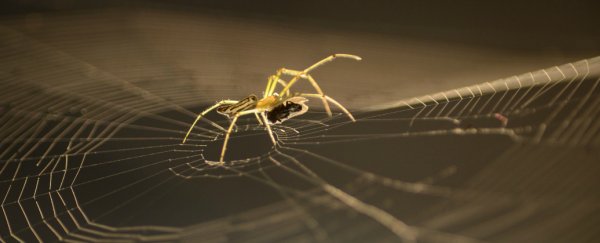Spider silk is already one of the toughest materials around, but scientists have now made it even stronger by spritzing spiders with water containing carbon nanotubes and graphene flakes.
In fact, the resulting super silk that the spiders produced in their webs is the toughest material ever measured, demonstrating strength and toughness beyond "anything that has been possible before," as MIT Technology Review reports. It sounds like something out of a Marvel comic, but the science actually makes a lot of sense.
We already know that spiders are able to weave a protein fibre that's super strong and stretchy, so a team of researchers from the University of Trento in Italy decided to see whether they could improve on nature, and make a substance that was even stronger.
They took 15 Pholcidae spiders from the Italian countryside and sprayed five of them with water containing graphene particles, and the other 10 with water containing carbon nanotubes. They collected the spider's silk before and after the experiment, before testing its fracture strength, toughness modulus and Young's modulus, which quantifies the stiffness of an elastic material.
"For each strand of silk, they fixed the fibre between two C-shaped cardboard holders and placed it in a device that can measure the load on a fibre with a resolution of 15 nano-newtons and any fibre displacement with a resolution of 0.1 nanometres," MIT Technology Review explains.
While some materials performed better than others, overall, the results were off the chart, and spectroscopic analysis showed that the carbon materials were present in the fibres.
"We measure a fracture strength up to 5.4 GPa, a Young's modulus up to 47.8 GPa and a toughness modulus up to 2.1 GPa. This is the highest toughness modulus for a fibre, surpassing synthetic polymeric high performance fibres (e.g. Kelvar49) and even the current toughest knotted fibres," the authors report in ArXiv.org.
However, the researchers still aren't sure how the carbon nanotubes and graphene particles were incorporated into the spiders' webs. It's possible that the silk is coated in the particles once its spun, but the team believe its more likely that the spiders ingest the water and spin it into the material as it's made.
"We have no direct evidence of this, but as the carbon nanotube or graphene is within the bulk of the silk and not just coating the surface, I suspect that it was incorporated during the spinning," Nicola Pugno, one of the researchers, told Emiko Jozuka over at Motherboard.
If they could find a way to replicate this process reliably and produce the material en masse, the potential would be huge, and could be used to create materials with superior characteristics, such as being strong and flexible, but also having the ability to become conductive.
As MIT Technology Review reports, it's not going to be an easy journey:
There are challenges ahead, of course. Nobody has discovered an efficient way to harvest spider silk, although not for lack of trying. So an important future step will be the development of such a technique that can work on an industrial scale. That would open the way to widespread applications in everything from tissue repair to garment design.
The team now hopes to try the same experiment with silkworms, in the hopes of creating a range of 'bionic materials'. "Today a lot of things are limited by their intrinsic material strength, but we can push this limit a bit," Pugno told Motherboard.
